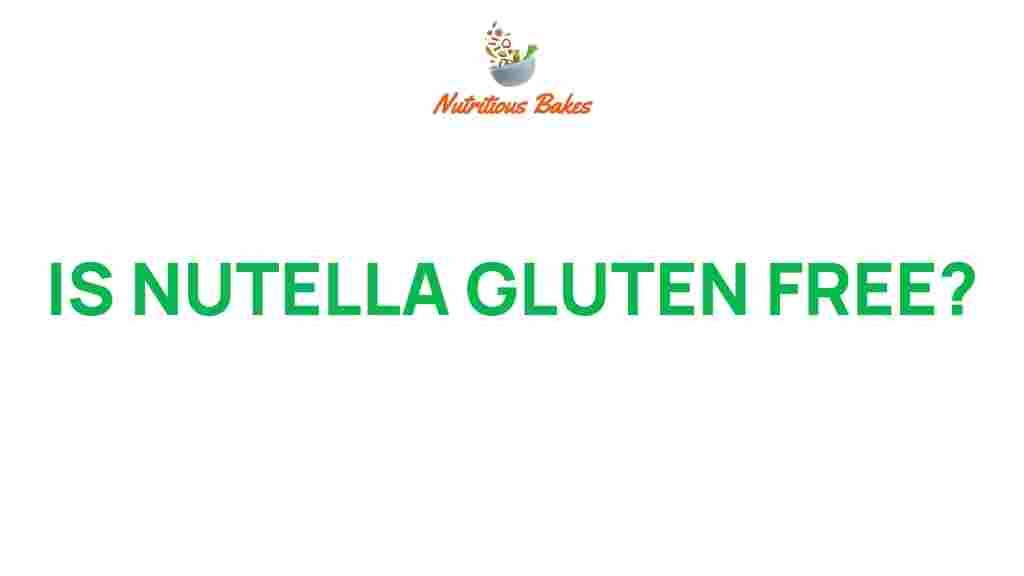Is Nutella Gluten Free? The Surprising Truth Revealed!
If you’re a fan of hazelnut spread, you’ve likely indulged in the creamy, chocolatey delight that is Nutella. This popular spread has become a staple in many households, but for those with dietary restrictions, especially gluten intolerance, a crucial question arises: Is Nutella gluten free? In this article, we will dive deep into Nutella’s ingredients, address dietary concerns, discuss food safety, and provide you with essential allergy information. By the end, you’ll have a comprehensive understanding of whether you can enjoy this delicious spread without worry.
Understanding Nutella’s Ingredients
To determine if Nutella is gluten free, we first need to look at its ingredients. Nutella is primarily made from:
- Sugar
- Vegetable oils (palm oil, hazelnut oil)
- Hazelnuts (13%)
- Cocoa solids (7.4%)
- Skimmed milk powder
- Whey powder
- Emulsifier (soy lecithin)
- Vanillin
As we analyze these components, it’s vital to focus on the presence of any gluten-containing ingredients. Gluten is primarily found in wheat, barley, and rye. Let’s break down the ingredients of Nutella further.
Examining Each Ingredient for Gluten
Here’s a closer look at each ingredient to see if they pose any risk for gluten intolerance:
- Sugar: Naturally gluten free.
- Vegetable oils: Typically gluten free, but be cautious of cross-contamination in processing.
- Hazelnuts: Gluten free and a key ingredient in Nutella.
- Cocoa solids: Pure cocoa is gluten free.
- Skimmed milk powder: Gluten free; derived from milk.
- Whey powder: Gluten free; a by-product of cheese production.
- Emulsifier (soy lecithin): Gluten free; derived from soy.
- Vanillin: Typically gluten free, used as a flavoring agent.
Based on this analysis, all the primary ingredients in Nutella appear to be gluten free. However, there are a few important factors to consider.
Cross-Contamination Risks
While the ingredients themselves are gluten free, cross-contamination can occur during processing. This happens when gluten-containing products are made in the same facility or on the same equipment as Nutella. To ensure safety, always check product labels for any disclaimers regarding gluten.
Understanding Product Labels
Product labels are your best friend when it comes to dietary concerns. Nutella does not carry a gluten-free certification, which can be a red flag for those with celiac disease or severe gluten intolerance. Always look for the following on the label:
- Gluten-free certification
- Allergen warnings (e.g., may contain traces of gluten)
- Ingredient lists for any changes or variations
For the most accurate information, refer to the official Nutella website or the product packaging. You can also visit the Nutella official site for the latest updates on ingredients and formulation.
Nutella and Dietary Concerns
For those with dietary restrictions, understanding what you consume is crucial. Here are some considerations:
- Celiac Disease: Individuals with celiac disease should exercise caution. Although Nutella’s ingredients are gluten free, the risk of cross-contamination is significant.
- Gluten Sensitivity: Those with gluten sensitivity may tolerate products with minimal cross-contamination; however, it’s best to consult with a healthcare provider.
- Vegan Diets: Nutella contains skimmed milk powder, making it unsuitable for strict vegans.
- Nut Allergies: Since Nutella is made primarily from hazelnuts, individuals with nut allergies should avoid it completely.
Nutrition Information
Another essential aspect to consider is the nutritional value of Nutella. A standard serving size (2 tablespoons or 37 grams) contains approximately:
- Calories: 200
- Total Fat: 11 grams
- Saturated Fat: 3.5 grams
- Carbohydrates: 23 grams
- Dietary Fiber: 1 gram
- Sugars: 21 grams
- Protein: 2 grams
While Nutella can be enjoyed as a treat, moderation is key, especially considering its sugar and fat content. Balancing it with healthier options is advisable.
Food Safety Considerations
Ensuring food safety is paramount, especially for those with allergies or intolerances. Here are some tips:
- Always read the label before consuming.
- Store Nutella tightly sealed in a cool, dry place to prevent contamination.
- If unsure about cross-contamination, contact the manufacturer for more information.
Troubleshooting Tips
If you’re considering incorporating Nutella into your diet but are unsure about its gluten content, here are some troubleshooting tips:
- Keep Updated: Ingredient formulations can change, so stay informed by regularly checking product labels or the official Nutella website.
- Consult a Professional: If you have dietary restrictions, consulting with a nutritionist or healthcare provider can provide personalized guidance.
- Alternative Products: If there’s any doubt, consider gluten-free hazelnut spreads available in the market. Many brands cater specifically to gluten-free diets.
Conclusion
So, is Nutella gluten free? The answer is that while the ingredients are gluten free, cross-contamination risks exist due to manufacturing processes. For those with celiac disease or severe gluten intolerance, it’s best to approach Nutella with caution. Always check product labels, stay informed about the latest ingredient formulations, and consult with healthcare professionals as necessary.
Ultimately, Nutella can be enjoyed by many, but understanding your dietary needs is crucial. If you’re looking for alternatives, numerous gluten-free hazelnut spreads are available to satisfy your cravings without compromising your health.
For more information on gluten-free diets and safe food choices, you can explore resources like the Celiac Disease Foundation.
This article is in the category Ingredients and created by NutritiousBakes Team
